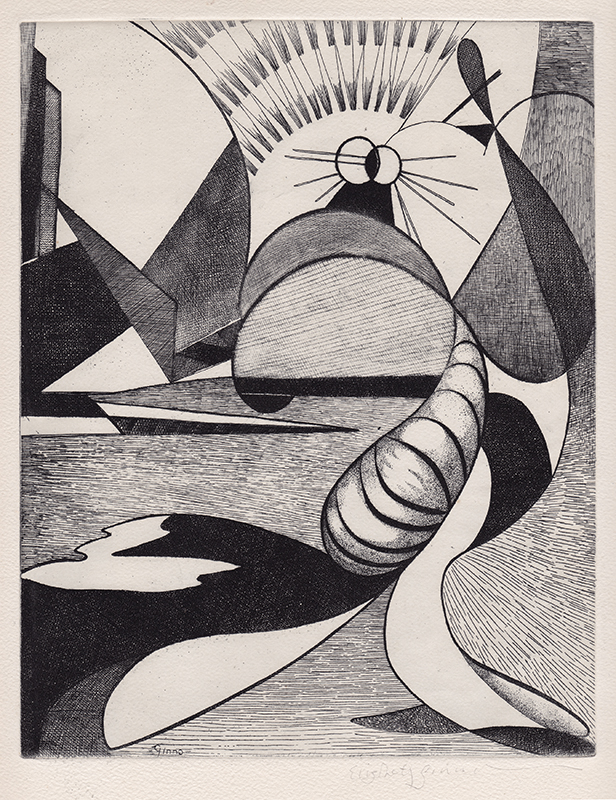The Beacon is a combination of line and softground etching created about 1940 by American artist Elizabeth de Gelele Ginno. This impression is pencil signed in the lower right and the plate is incised with the artist’s name in the lower left image. The Beacon is a proof printed by the artist on a textured, ivory wove paper. The exact number of impressions is unknown but assumed to be quite small and the platemark measures 9-1/2 x 7-1/2 inches.
The Beacon is a richly printed impression from a highly textured softground plate. To create her surrealistic image, Ginno etched sweeping curves segmented by color, line and texture. She created a sort of horizon line above which sits the beacon which radiates light in a pattern quite similar to the light patterns on the top of the deco Chrysler Building. Her intent is unknown but her image shows off her skills as an etcher.
Elizabeth de Gebele Ginno, dancer, painter, printmaker, draftsman, and administrator, was born in Plumstead, England on 8 July 1907, arriving early to American parents who were visiting family. Her parents, John William and Leonore Freda (Hermann) Ginno, were both dentists. She was raised in Berkeley, California and became a drama major at Mills College in Oakland where she met Imogen Cunningham and Roi Partridge. She also studied at the California College of Arts and Crafts and the California School of Fine Arts and also studied etching and drawing with John W. Winkler. According to the US Census of 1930, she was married to Carol Parsons Aronovici, Jr. Aronovici was a make-up artist, costumer, actor and set designer and together they established Stagecraft Studios in Berkeley, a theatrical supply business. The couple divorced in 1934.
Ginno was employed by the Works Progress Administration during the Depression. During the second season (1940) of the Golden Gate International Exposition held on Treasure Island in San Francisco, Ginno gave a printmaking demonstration for Art in Action, a live exhibition of artists at work held in the Hall of Fine and Decorative Arts. The concept was a working art exhibition with sculptors, painters, muralists, weavers, printmakers, and potters making their art in front of the public. During the long run of the fair, Ginno created a series of etchings based upon the costumes of foreign countries.
Ginno was a member of and exhibited with the California Society of Etchers, the Society of American Etchers, the Chicago Society of Etchers, and San Francisco Women Artists. In 1954, Ginno and Augusta Rathbone had a two-person exhibition at the de Young Memorial Museum in San Francisco and the Crocker Art Museum in Sacramento, California.
In 1955, Ginno became president of the California Society of Etchers and, in 1968, she invited the Bay Printmakers Society to join the California Society of Etchers. The merger of the two organizations, orchestrated by Ginno, John Ihle, and Karl Kasten, resulted in the California Society of Printmakers. Ginno steered the organization for a few more years before resigning from the board of directors.
Ginno worked for thirty-five years in the engineering department at the University of California Berkeley as a draftsman and illustrator. In addition to her own artistic pursuits, Ginno was an ardent advocate and promoter of the work of etcher John W. Winkler whom she married in 1949.
Ginno’s work is represented in the collections of the Georgia Art Museum University of Georgia, Athens; the Mills College Art Gallery, Oakland; the Fine Arts Museums of San Francisco; and the National Gallery of Art, Washington, D.C.
Elizabeth de Gebele Ginno is featured in Maurine St. Gaudens’ four-volume Emerging From The Shadows: A Survey of Women Artists Working in California, 1860-1960 [Schiffer, 2015].
Elizabeth de Gebele Ginno Winkler died in El Cerrito, California on 9 December 1991.



